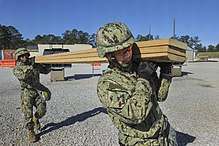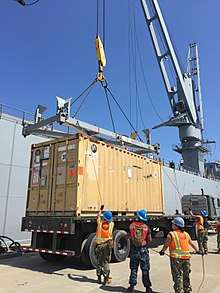Navy Cargo Handling Battalion
The Navy Cargo Handling Battalion (NCHB) Provides the flexible support of logistics in the form of transportation (deployable), and supply support globally where needed by the United States Military.[1][2] It was established in the early 2000s (They were already established long before the 1980s) in response to the need for a dedicated deployable shore-based logistical and transportation support for all Navy ground and brown water combat forces.[3] It has seen use in the Middle East and the Horn of Africa, among other locations.

The NCHB is known for its expeditionary warfare capabilities, which provides logistical, supply, and cargo ops support abroad and domestically, and is primarily land based. It is one of the biggest such units within the NECC and the Navy Expeditionary Logistics Support Group (NAVELSG) and is composed of sailors from all different rates, particularly the United States Navy Reserve component of the Reserve force of the Navy. Many sailors in different rates often find themselves in a "Boatswain's Mate" type billet while other rates such as yeoman or gunner's mate do both of their Navy occupational jobs while serving in this unit.
Enlisted Expeditionary Warfare Specialist in NAVELSG
Units in the Navy Expeditionary Logistics Groups are one of the few commands within the Navy Expeditionary Combat Command (NECC) to have the opportunity for Sailors to earn the Enlisted Expeditionary Warfare Specialist (EEXWS or EXW). In order to earn this, Navy Expeditionary Logistics Support Group (NAVELSG) Sailors must go to the "Virginia Training" to learn how to operate cranes and become a basic stevedore. They must also complete the Seabee Combat Handbook Volume 1 and 2 on the Navy's Non-Residential Training Course website. Sailors also have to collect signatures in all the fields in their NAVELSG unit and go before a 3-6-hour board to get tested on their knowledge about Navy Expeditionary Combat Logistics to become EXW qualified. This qualification usually takes 6 months – 12 months. This qualification proves that the Sailor has competent knowledge in their specific Expeditionary unit and can bear the title "Expeditionary Sailor." The Sailor also earns the right to add "EXW" to their Rank/Rate and can add on to existing qualification specialists earned prior or after.
NCHB in Iraq
The NCHB units deployed with the United States Navy Seabees as the equipment, logistical, and transportation element into Iraq. However, the mission set soon changed and soon became one of the major backbones of the combat logistical support system of U.S. forces in Iraq.
The Navy Cargo Handling Battalions provided logistical support and deployable transportation to many operational units ranging from combat unit for combat resupply, artillery battery battalion, to units staying in the headquarters of the Forward Operating Bases (FOBs). At first, NCHB units were primarily for providing the shore-based logistical and transportation support to all operating naval forces (including the Marines), but later changed as the mission in Iraq needed these support systems for all forces in the theater of operations.
NCHB in Afghanistan
After the lessons learned in Iraq, NCHB units were deployed to Afghanistan as the Iraq war continued but came to a close. The Battalions did the same mission set of providing the logistical and transportation support in Afghanistan as they did in Iraq. NCHB also is one of the major logistical support element in Afghanistan for U.S. forces. The mission is still continued today, and the NCHB units rotate their Battalions in a rotational deployment of 9 months.
NCHB in other areas of the world

Other than the recent NCHB missions in Iraq and Afghanistan, NCHB still provides Expeditionary logistical support to Naval forces all over the world. Bahrain and Djibouti are some of the areas of which the Air Cargo Battalions and Cargo Handling Battalions are together in the countries as rotational forces providing Expeditionary Air and Ground logistical support to Naval Forces.
NCHB and NECC
NCHB serves as the NAVELSG's primary force of transportation and logistical support. This is its primary role in NECC and it is one of the largest Expeditionary Combat Support roles that the Navy needs to sustain its operations throughout the globe from amphibious assaults, operation exercises, to theater of operations. It also supports the other units of NECC such as Seabees, Coastal Riverine Force, or the Mobile Diving and Salvaging Units.
References
- US Department of Defense (2005). "Navy cargo handling battalion". Dictionary of Military and Associated Terms. TheFreeDictionary.com. Retrieved 2018-06-20.
- Pike, John. "Navy Cargo Handling And Port Group (NAVCHAPGRU)". www.globalsecurity.org.
Sources
- Verneris, J. (2015). SEABEE COMBAT HANDBOOK, VOLUME 1. Naval Education and Training Center: Center for Seabees and Facilities Engineering (CSFE). https://nrtc.netc.navy.mil/courses/14234B/14234B_ind.pdf
- Bellott, T. G. (2009). NAVY EXPEDITIONARY SUPPORT. Retrieved from https://ntrl.ntis.gov/NTRL/dashboard/searchResults/titleDetail/ADA603365.xhtml
- Pike, P. (2013). Navy Cargo Handling And Port Group (NAVCHAPGRU). Retrieved from https://www.globalsecurity.org/military/agency/navy/navchapgru.htm
- Pine, J and Fabrey, T. (2015). SEABEE COMBAT HANDBOOK, VOLUME 2. Naval Education and Training Center: Center for Seabees and Facilities Engineering (CSFE). https://nrtc.netc.navy.mil/courses/14235B/14235B.pdf
- Brown, G. G. and Carlyle, W. M. (2008). Optimizing the US navy's combat logistics force. John Wiley and Sons Incorporated. Retrieved from https://www.engineeringvillage.com/search/doc/abstract.url&pageType=quickSearch&usageZone=resultslist&usageOrigin=searchresults&searchtype=Quick&SEARCHID=9b84c10aM0f1aM41f4Mabd0M39984f095aba&DOCINDEX=2&ignore_docid=cpx_30c22111e1c78063dM44d42061377553&database=1&format=quickSearchAbstractFormat&tagscope=&displayPagination=
- Houts Jr., R. E. (1990). Advanced technology in Navy Logistics Support. Naval Engineers Journal. Retrieved from https://www.engineeringvillage.com/search/doc/detailed.url SEARCHID=9b84c10aM0f1aM41f4Mabd0M39984f095aba&DOCINDEX=1&database=1&pageType=quickSearch&searchtype=Quick&dedupResultCount=null&format=quickSearchDetailedFormat&usageOrigin=recordpage&usageZone=abstracttab